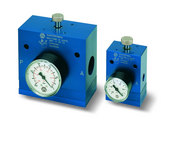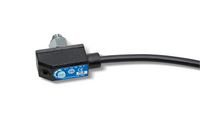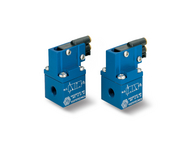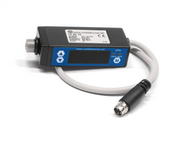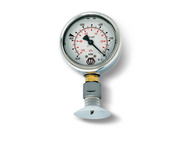Vuototecnica vacuum measurement, control & adjustment instruments
Vacuum & pressure gauges
The measurement method of our vacuum gauges is based on the principle of the Bourdon spring (Eugène Bourdon, France, 1808–1884).
It is made using section tubes in special copper alloy, one end is welded to the threaded pin of the vacuum-pressure gauge, thus forming a single body with it, while the other closed end is free As the vacuum or the pressure inside increases, it tends to shift from the initial position (Bourdon effect). The movement of the free end of the spring determines the vacuum-pressure measurement. In order to allow an easier reading, this movement is amplified by means of a connection lever and transmitted to the pointer. It is enclosed in a sturdy metal casing which contains the dial and the pointer that can be seen through a glass. They are available in various versions, with coaxial or radial connectors, with built-in or external flange, dry or glycerine filled. Except for vacuum gauges with diameter Ø 40 mm, all the other models have a double scale dial. All the vacuum and pressure gauges we will describe in these pages are made in compliance with all the safety standards and measurement units in force in the European Union.
Vacuum gauge with steel punch
This vacuum gauge has been designed to allow the immediate detection of the vacuum level inside tin cans and food containers in general.
The glycerine bath vacuum gauge used for this application is provided with a hardened steel punch to easily perforate the containers and with a vacuum cup in silicon compound to guarantee vacuum seal after perforation.
It is available in the standard version but upon request can be provided in other versions.
Mini pneumatic vacuum switch
These vacuum switches feature reduced overall dimensions and, according to the model, they give or remove a pneumatic signal when a certain adjustable vacuum level is reached. The pressure differential between the set maximum value and the value of reset of the rest signal is not adjustable. They are particularly suited for controlling vacuum generators and for activating pneumatic valves.
Mini electromechanical vacuum switches
These vacuum switches feature reduced overall dimensions and give an electric signal when a certain adjustable vacuum level is reached. The pressure differential existing between the set maximum value and the value of reset of the rest signal is 50 ÷60 mbar and it is not adjustable. They are particularly suited when an electrical signal is needed when a certain vacuum level is reached, for safety, for starting a cycle, for checking the cup grip, etc.
Electromechanical vacuum - pressure switches
The 836 series vacuum - pressure switches are compact, sturdy and accurate units that can be adapted to many applications. The feature of the control is a quick tripping precision micro-switch, equipped with silver contacts. Normal industrial vibrations have no effect on the efficient opening and closing of the contacts.
The particular linear construction, relatively friction free, assures a precise and reliable operation independent of the pressure switch mounting angle. The “Long Life” bellows with which they are equipped, are made of copper alloy and can be used for air, water, oil, liquid, vapour and gas circuits, provided that all these agents are not corrosive.
These devices are included in the U.L. lists and approved by C.S.A.
Micro digital vacuum switches
These small devices, if accurately calibrated and compensated for temperatures, are able to give very precise digital signals to the set maximum measuring value. The commutation point, which is within the scale value, can be easily programmed by means of an adjustment screw located on the upper part of the device. A red LED near the screw indicates the digital output signal commutation status. The pressure differential (hysteresis) between the set maximum value and the value of reset of the rest signal is 2% of the set value and cannot be adjusted. They are composed of a polycarbonate enclosure, which includes the sensor and the electric circuit, and of a coupler or a small aluminium manifold with the vacuum connections. Art. 12 05 10 can also be rotated freely to place the display in the desired position, without having to unscrew it from the vacuum connection. The vacuum connection can be carried out via male or female M5 connectors, while the electrical connection is made via a three-connector cable which they are equipped with. Mini digital vacuum switches are suited for controlling dry air and non-corrosive gasses and they are recommended in all those cases that require a signal when a certain vacuum level is reached, for safety, for starting a cycle, for checking the cup grip, etc.
Analogue vacuum switches
These compact and extremely light switches come enclosed in a sturdy ABS casing; these features allow their installation on the machine and close to the application. If accurately calibrated these analogue switches provide very precise measurements values. The adjustment range is from 0 to -1 bar (g) and can be interfaced with external logics via an analogue output from 1 to 5 Volts and a digital PNP output, configurable via Teach-In. The commutation point, as well as the hysteresis from 0 to 100% of the set value, can be easily programmed via push buttons located on the control panel; the two two-colour LEDs on the control panel signal the commutation status and the error code, if any. These devices can be rotated freely to place the display in the desired position, without having to unscrew them from the vacuum connection. The vacuum connection is dual threaded: male G 1/8” or female M5. The electrical connection is an M8 4-pin threaded plug and upon request the connection cable is available in PUR, with an axial or radial connector. These vacuum switches are suited for measuring and controlling dry air and non-corrosive gasses. They are recommended in all those cases that require a measurement and commutation to be installed on safety or energy-saving devices, on systems for optimising the work cycle time and in circuit vacuum level adjustment circuits.
Digital & vacuum pressure switches
These compact and extremely light digital vacuum and pressure switches are enclosed in a sturdy ABS casing. These features allow installation on the machine and close to the application. These digital switches, accurately calibrated and compensated for temperatures, is able to give very precise measurements values. The measured values are shown on the display, making the vacuum gauge redundant. The two LEDs, one red and one green, built-in the control panel, indicate the commutation status of the two digital output signals. The two commutation outputs are completely independent. The switch point between the scale values as well as the hysteresis from 0 to 100% of the set up value can be easily programmed via the push buttons on the control panel. Other additional functions can be configured, such as the comparison between two values, NO and NC contacts, choice of the measurement unit, locking the programmed values and functions, display reversal, etc. These devices can be rotated freely to place the display in the desired position, without having to unscrew them from the vacuum connection. The vacuum or the pressure connections can be carried out via a dual male G 1/8” or female M5 thread. The electrical connection is carried out via M8-4 pin threaded plug and upon request the connection cable is available in PUR, with an axial or radial connector. These switches are suited for measuring and controlling dry air and non-corrosive gasses. They are recommended in all those cases that require a signal when a certain vacuum level is reached set for safety, for starting a cycle, for checking the cup grip, etc. Moreover, the hysteresis function allows managing the vacuum generator compressed air supply, allowing considerable energy saving.
Vacuum regulators
Vacuum regulators are used to adjust the pre-set vacuum level, keeping it constant (secondary vacuum), regardless of the capacity and the oscillations of the network vacuum level (primary vacuum).
Their operation is with a membrane-piston and they exploit the pressure differential between the secondary vacuum and the atmospheric pressure. Unlike the vacuum adjusting valves, regulators do not introduce air into the circuit, thus producing more gripping points with different vacuum values, from only one vacuum source.
The vacuum level is adjusted by rotating the special reeded screw clockwise to increase it, and anti-clockwise to reduce it.
Technical features
- Operation: membrane-piston regulator
- Adjustable operating pressure: from 800 to 1 mbar abs.
- Capacity: from 2 to 160 cum/h
- Room temperature: from -10 to +80 °C
- Installation position: any
Use
Vacuum regulators are mainly used on centralised plants where, regardless of the plant vacuum level, each grip can be adjusted within that value.
Moreover, they are necessary whenever the working vacuum must be lower than the primary vacuum.
Vacuum adjustment valves
When these valves reach a certain pre-calibrated vacuum degree, they introduce atmospheric air into the circuit to prevent the increase of the set value and to keep it constant. They can be used as regulators only on circuits having only one vacuum pump and only one use (or more uses but all working at the same vacuum degree).
In most cases they are used as safety valves on non-commissioned tanks or containers at high vacuum levels and on vacuum cup lifting systems. The vacuum level is adjusted by rotating the knurled bush in both directions. The fine thread with which the valve is provided ensures a very accurate calibration.



